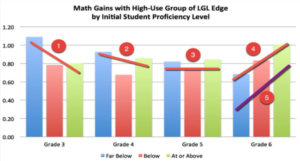Why Middle Schools in the United States Struggle to Teach Their Students Math
Middle school math can be challenging for many students due to a variety of factors. It is important to understand these factors in order to find the best approach in systematically applying a solution, whether at the student, classroom, school, or district level.
First, the math curriculum itself becomes more complex during the middle school years. With the introduction of advanced concepts, students must transition from arithmetic to more abstract thinking. Unfortunately, many students have gaps in foundational skills as well. This can pose difficulties for them as they try to learn problem-solving skills in new ways while trying to remember foundational skills to support this learning. In addition, in the sixth grade, an inflection point occurs where being behind means not learning. See this white paper on secondary math reform for data supporting this statement. See an except graph from this white paper below.
Second, classroom logistics for teaching middle school math often lack flexibility to meet the needs of today’s students in today’s schools. Rigorous content means little to no time for review. Regular-sized classrooms mean little to no personalization, with minimal scaffolding.

At sixth grade, the purple line (5) shows the drop off of baseline learning for different groups of students (Far-below, below, and at or above, at the start of the year). Thus, interventions over the course of the year (4), even though providing additional marginal gains, may not catch students up.
Next, there is often an inflexible mindset focused on adhering to standards-based pacing guides above all else. This practice is often tied to the content approach of teaching secondary math. By sixth grade and above, math teachers often see themselves as conveying a fixed set of content over a fixed period of time. However, this mindset defies common sense given the below grade-level abilities of incoming students into most classrooms in middle school and above. When only 35-40% of students in an entering middle school math class have attained proficiency in the previous year’s math standards, a standards-based pacing curriculum cannot be followed. A differentiated core model or intervention model must be adopted. Doing nothing is akin to allowing a class to enter third-year French when 60-65% failed French 2.
Another interesting factor is that parental involvement often drops off, as parents commonly lack the confidence or knowledge to assist with middle school math, especially as the topics get more complex. This can make it more challenging for students to receive help outside of school.
Finally, the social-emotional aspect of education, which includes building positive teacher-student relationships and fostering a sense of community among students, can have a significant impact on math learning. Middle school often shifts to more formal lecture-style classes that may lack supportive relationships, affecting students’ motivation and engagement with the subject.
To address these issues, it’s essential to implement strategies that cater to the unique needs of middle school students. This might include ensuring strong teacher-student relationships, providing additional professional development for teachers in personalized learning, implementing intervention practices, or changing site-level practices, such as creating a common math period during the day or adding an extra intervention period by reducing all classes by five minutes. There are plenty of examples of success in this area, but site or district administrators have to be willing to think outside the box.
Let's Go Learn's diagnostic assessments
With Let’s Go Learn, you can create personalized instruction that inspires success for each learner, as you differentiate curriculum for intervention, remediation, and enrichment.


Leave A Comment